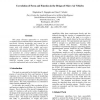Free Online Productivity Tools
i2Speak
i2Symbol
i2OCR
iTex2Img
iWeb2Print
iWeb2Shot
i2Type
iPdf2Split
iPdf2Merge
i2Bopomofo
i2Arabic
i2Style
i2Image
i2PDF
iLatex2Rtf
Sci2ools
EH
2002
IEEE
2002
IEEE
Coevolution of Form and Function in the Design of Micro Air Vehicles
This paper discusses approaches to cooperative coevolution of form and function for autonomous vehicles, specifically evolving morphology and control for an autonomous micro air vehicle (MAV). The evolution of a sensor suite with minimal size, weight, and power requirements, and reactive strategies for collision-free navigation for the simulated MAV is described. Results are presented for several different coevolutionary approaches to evolution of form and function (single- and multiple-species models) and for two different control architectures (a rulebase controller based on the SAMUEL learning system and a neural network controller implemented and evolved using ECkit).
| Added | 14 Jul 2010 |
| Updated | 14 Jul 2010 |
| Type | Conference |
| Year | 2002 |
| Where | EH |
| Authors | Magdalena D. Bugajska, Alan C. Schultz |
Comments (0)

